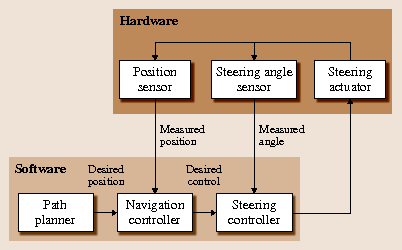

This is the emergent concept of fleets of robots, which represents a step forward in agriculture. Many research groups are developing specialized autonomous applications for agriculture that will be operative in the coming years, but many others are also aiming to operate a group of vehicles under unified control. Thus, devising a simple controller for both vehicle and implement would facilitate reliability, efficiency, and competitiveness. Minimizing the hardware of the vehicle-implement system is essential for commercializing reliable, efficient, and cost-competitive agricultural machinery. Thus, when integrating a given vehicle and a particular implement, many sensors and/or actuators are duplicated and, worst of all, a central, external computer must be used to coordinate the arrangement: vehicle and implement. Those implements (variable application rates of fertilizers or sprays, mechanical intrarow weed control, and seed planters) are also being automated with the same types of sensors and actuators used in autonomous vehicles (GPS, machine vision, range finders, etc.). These autonomous/semiautonomous systems provide accurate positioning and guidance in the working field, which makes them capable of conducting precision agricultural tasks if equipped with the proper implements (agricultural tools or utensils). In the last twenty years, specialized sensors (machine vision, global positioning systems (GPS) real-time kinematics (RTK), laser-based equipment, and inertial devices), actuators (hydraulic cylinder, linear, and rotational electrical motors), and electronic equipment (embedded computers, industrial PC, and PLC) have enabled the integration of many autonomous vehicles, particularly agricultural robots. The architecture presented in this paper is being successfully applied in the RHEA fleet, which comprises three ground mobile units based on a commercial tractor chassis. This work also studies diverse topologies for controlling fleets of robots and advances other prospective topologies. Several solutions are studied, from a fully distributed to a whole integrated architecture in which a central computer runs all processes.
#History of automation in agriculture software
This paper strives to develop a system architecture for both individual robots and robots working in fleets to improve reliability, decrease complexity and costs, and permit the integration of software from different developers. A step forward in the application of automatic equipment in agriculture is the use of fleets of robots, in which a number of specialized robots collaborate to accomplish one or several agricultural tasks.


Hardware minimization, as well as software minimization and ease of integration, is essential to obtain feasible robotic systems. However, the incorporation of many electronic systems into a robot impairs its reliability and increases its cost. Computer-based sensors and actuators such as global positioning systems, machine vision, and laser-based sensors have progressively been incorporated into mobile robots with the aim of configuring autonomous systems capable of shifting operator activities in agricultural tasks.


 0 kommentar(er)
0 kommentar(er)
